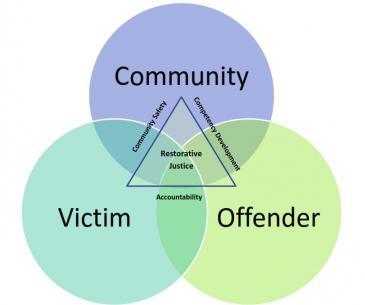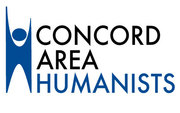Posted on April 16, 2014 by David

Last night at the Discussion Group Meeting of the Concord Area Humanists, the subject of justice came up and it was apparent that most people in this group were not aware of an alternative justice system called Restorative Justice. So I thought I would present a very basic tutorial.
First, for some scientific grounding based on neurobiology. Scientists are constantly discovering more and more functions of the amygdala – a part of the brain. (Wikipedia and Amygdala) This amygdala is responsible for our emotional reactions (not necessarily our emotional states) such as fight or flee. It is the seat of many fears. And it is also the seat of our empathy. It has been scientifically shown that many people who have shown disturbing behaviors such as murders and physical attacks have less developed amygdalas. These people are very low in terms of empathy and cannot feel what others feel adequately. This is not to say that such people should not be held responsible for their actions.
It has also been shown that the amygdala can become more developed in the right environment. However, our prisons, which are like the cages that rats were kept in for tests reveal an environment that actually decreases the development of the amygdala. It is no wonder that someone with a less-developed amygdala, performs a crime and is sent to prison and is then released after 12 years with an even less-developed amygdala. Such people are very likely candidates for re-incarceration after more socially unacceptable behavior which harms society.
So it behooves a society to treat people with less-developed amygdalas by putting them in an environment where their amygdalas can develop. And as Humanists, our goal is to develop all that it means to be human both in ourselves and in others. This includes people with less-developed amygdalas.
For a more complete explanation, please watch this presentation from a TED Lecture:
In this presentation, Daniel Reisel mentions Restorative Justice but doesn’t really describe or define it. Of course it could take a book to describe, but I thought I would present an introduction to it by differentiating it with our current punitive and litigious system. I will present it and the differences in its premise, its process, and its penalties. (Can you see that I took a course in Hermeneutics? Smile)
First the premise. The premise of our current justice system is that crimes are committed against the State. That is why the trials and the players - the judges, the prosecuting attorneys, and often the defense attorneys - are State employees. The premise is that a crime was committed against the State. In Restorative Justice, the premise is that the crime is committed against a community – not just an individual. For an example, I will take a case where Person A assaults Person B. The crime is more than just against Person B. The crime is against all of the stakeholders who were harmed – not just physically. The spouse of Person B was also harmed by having to tend and care for Person B during their rehabilitation. Neighbors might also have been harmed by having Person B incapacitated. Person’s B’s boss was harmed during the time that Person B was out of work. The big question in Restorative Justice is first to determine WHO was harmed in order to give them a voice in the proceedings.
However the community around the perpetrator, Person A, is also involved as stakeholders. They may provide defenses or even submit extenuating circumstances or collaborative evidence. But also, if Person A is adjudged to be guilty, the community of Person A must be taken into consideration when assessing the penalty. (More about that later when I discuss the Penalty section.)
The process of Restorative Justice is also very different. In our current system, the process is that the whole theater of the trial is played out by two litigious lawyers each with their own goals and objectives. Each has an objective to win the case. The prosecuting attorney is looking for a guilty verdict, and the defense attorney is looking for an acquittal. Each knows that their future positions will be determined by their win/loss ratios. The defense attorney is often not looking for justice, but rather is looking for a win. And the prosecuting attorney too often is looking for a win rather than looking for justice. They will argue legal points of the case in an effort to win regardless of the people involved.
And too often in trials, the people affected are often not allowed to present their own story. Most defense lawyers will not allow a defendant to testify. And often even a victim is not allowed to tell their own story. If the victim is put on the witness stand, they are only allowed to answer directly the questions which are given to them by the lawyers. Many victims feel cheated because their story was not allowed to be told. And many defendants feel cheated because they were never allowed to tell their story.
In Restorative Justice processes, once the community has been identified, they are often arranged in a circle similar to the Native American councils. Going around the circle, each is given an opportunity to present their own story so everyone is heard. In this case, Person A can hear the harm that was done to Person B and Person B’s community. Often Person A is not aware of the harm which has been done – especially to the whole community. It is often very therapeutic for a victim to explain to the perpetrator the consequences of their actions.
The penalties in our current system is usually incarceration. The perpetrator is sentenced to a period of time in prison and the case is closed. However no thought is made to the rehabilitation of the convicted person nor of the penalties imposed on Person A’s family. When a person is sent to prison, often that person may be working and earning an income. Now the family of an incarcerated parent has to do without that income. Often mothers are sent to jail a great distance away from the home so the children are not even allowed to visit her. Again, if a person is sent to prison who is working, that person’s employer is affected and harmed. The prisons are designed to incarcerate people, not rehabilitate them. With a person sent to prison, there is no chance to have the harm restored to the victims.
The penalties of Restorative Justice take all these issues into consideration. It will often realize that the best penalty for an offender is often not to incarcerate them. Rather, the question is raised as to how the offender can restore the harm. If the offense was theft, it is better that the perpetrator be allowed to continue working at their job in order to restore or return what was stolen. It is sometimes better to have the offender work for the victim on weekends in order to restore the harm. It is better to keep the offender’s family intact even if it means that the family contributes to the restoration. Restoration is a key principle to Restorative Justice. For the community to come up with an acceptable penalty makes everyone realize the value of the community in administering justice.
The biggest problem with Restorative Justice is that few people know that this is an alternative to our current unworking (and unworkable) justice system. A few places have instituted Restorative Justice into their community. Brattleboro, Vermont has a good system in place. Concord, MA also has a limited Restorative System in place in Concord and some outlying communities. (Communities for Restorative Justice) In Concord, the Restorative Justice system incorporates the police department in administering Restorative Justice to youth offenders. Rather than young people getting a prison sentence or a criminal record for the rest of their lives, the police realize that it would be better for these youth offenders to go through the Restorative Justice system. From what I understand, it has been very successful and is used as a model for other communities interested in instituting Restorative Justice.
Restorative Justice may not be the best system for all cases, but it is definitely better than the present system in many cases in providing a humane approach to justice. And that is something that we as Humanists should be aware of.
David Kimball


Add your comment